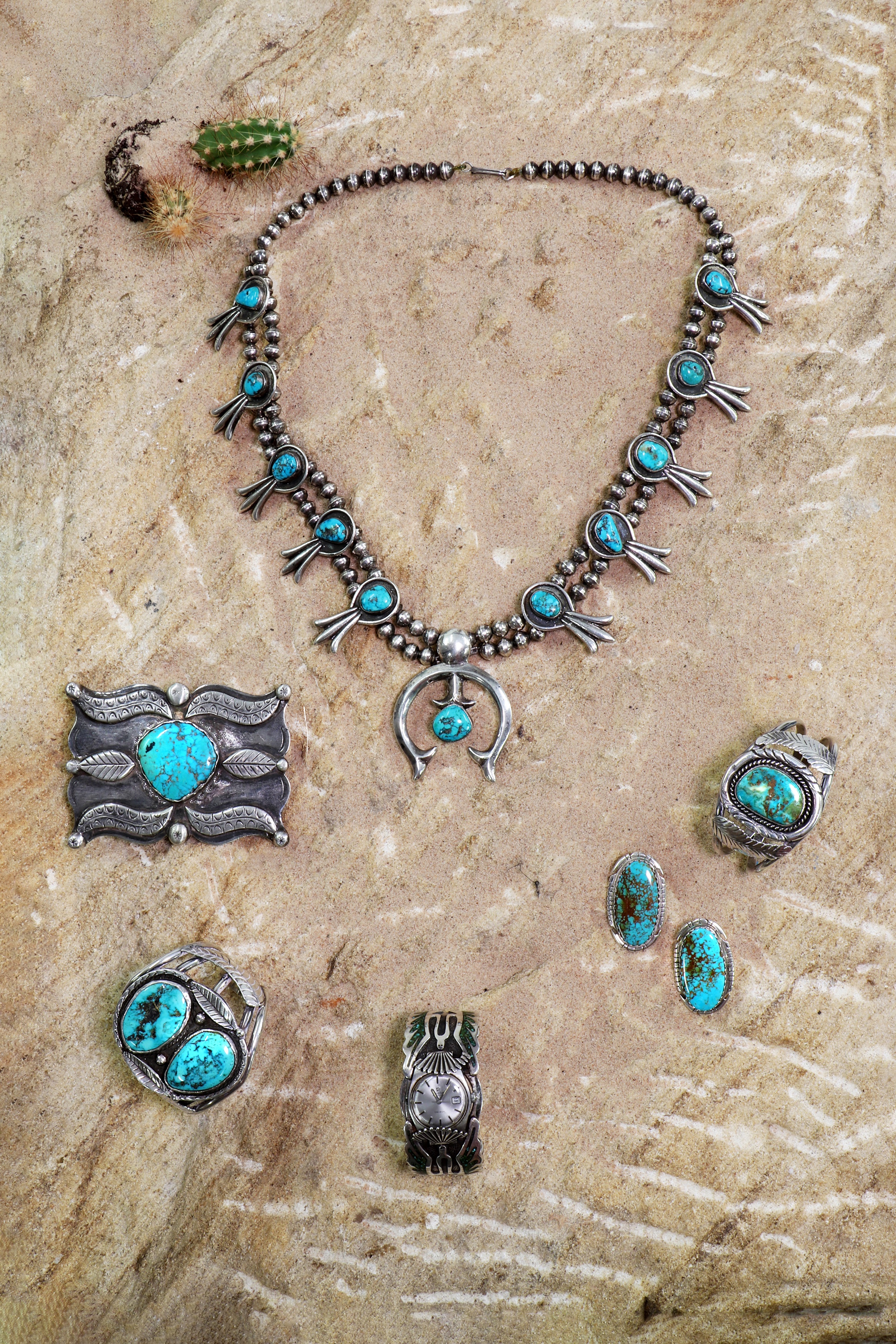

When a local private vendor approached us with a collection of Navajo Jewellery for inclusion in our forthcoming auction of Fine Jewellery and Watches, we felt compelled to delve deeper into the history of the craft…
The Native American Navajo tribe’s tradition of jewellery making dates back to the 19th century when tribe members began working with silver acquired from the Spanish.
Atsidi Sadi is widely believed to be the first Navajo to learn the craft of silversmithing, evolving his primary skill of blacksmithing to work with the metal in as early as 1860. The earliest items to have been discovered are concho belts made from hammered Mexican or U.S. silver coins, bracelets and necklaces, but as the tribe perfected their craft, they expanded to produce a full range of decorative jewellery.

Pictured clockwise from top:
Lot 275 - A silver Navajo turquoise squash blossom necklace, estimate £400-600
Lot 277 - A silver Navajo torque style cuff bangle, together with a pair of silver Navajo earrings, estimate £100-150
Lot 279 - A silver Navajo bangle, fitted with a ladies' stainless steel Omega automatic watch head, estimate £100-150
Lot 278 - A silver Navajo turquoise set torque bangle or cuff, estimate £150-250
Lot 276 - A silver Navajo turquoise set belt buckle, c.1970, estimate £200-400
Turquoise began to appear in Navajo Indian jewellery in around 1880, believed to have been sourced from the Santo Domingo tribe, and by 1885, the gemstone was in high demand. One story goes that the Ancient Native Americans believed turquoise to be pieces of the sky. In prehistoric times it was mined for adornment purposes – to produce drilled beads and ornaments. It remains popular to this day due to its unique hue and patterning.
When tourism elevated in the 1920s, visitors to the area were keen to bring back a piece of Navajo jewellery as a souvenir. Particularly popular were squash blossom necklaces, with their hallmark tri-petal silver beads. Supposedly, the shape of these beads was inspired by the Spanish design of a pomegranate. The centrepiece of a squash blossom necklace is the naja crescent-shaped pendant. Worn for beauty and pride - the crescent did not necessarily symbolise a respect for Christianity or the Moorish influence on the Spanish from whom the Navajo people borrowed the symbol.
Today’s Native American Navajo jewellery encompasses both tribal and Spanish designs, combining the traditional and the contemporary to transcend old styles.
Lots 272-279 – Fine Jewellery & Watches, Tuesday 27 July
For more information about the collection and the forthcoming sale, please contact:
Catriona Smith
catrionasmith@sworder.co.uk | 01279 817778
A remarkable collection of 177 lots of rare and historic Bibles feature in our timed auction of Books, Manuscripts and Maps from 17-27 April, offering collectors, scholars and history enthusiasts a unique opportunity to own some of the most significant early English translations of the Holy Scriptures. The collection showcases centuries-old editions that played a pivotal role in shaping religious thought, language and culture.
15 April 2025
Ahead of his upcoming ‘retirement sale’ on 13–14 May, we caught up with the ever-charismatic Paul Atkinson to uncover some of the captivating stories behind the lots on offer.
11 April 2025
With styles and silhouettes endlessly evolving during the Victorian period, the continuous advancements in fashion offered women more choice and freedom regarding their attire. Sworders are delighted to present a collection of Victorian clothing in our upcoming Jewellery, Designer Handbags & Accessories sale, taking place on Wednesday 23 April.
9 April 2025